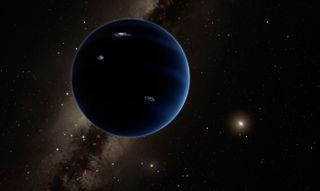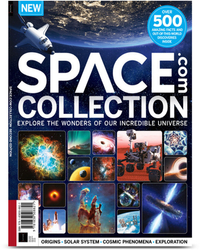Planet 9 probably doesn't exist, new paper argues
Is anything out there?

Does the solar system have a big, dark ninth planet drifting somewhere far beyond the orbit of Neptune?
Since 2016, many astronomers have said it's possible, pointing to evidence for a large gravity source in deep solar space. But a new paper argues that this gravity source is nothing more than a statistical mirage, the consequence of where in the night sky astronomers point their telescopes. The first physical(CK) hint of this hypothetical Planet Nine was a group of space rocks with similar orbits that seemed to be clustered unusually close together. These dim, distant, hard-to-spot objects orbit beyond Neptune and are known as "trans-Neptunian objects" (TNOs).
Related: 5 reasons to care about asteroids
Because these frigid little worlds in the far-outer solar system reflect such little sunlight, they tend to blend into the brighter background of stars and galaxies that occupy most astronomers' attention, and only a handful have ever been identified and catalogued. (The most famous of these is the demoted dwarf planet Pluto, which orbits relatively close to the sun compared with many of its TNO cousins.)
But in 2016, astronomers Konstantin Batygin and Mike Brown of the California Institute of Technology noticed that six TNOs, including the dwarf planet Sedna, all had long elliptical and "eccentric" orbits oriented in the same direction. Eccentric here means that their aphelions, or most-distant points, are much further from the sun than their perihelions, or closest points to the sun. And all six had aphelions on roughly the same side of the solar system. In a 2016 paper published in The Astronomical Journal Batygin and Brown wrote that a planet with a mass of around 10 times that of Earth, way further out than Pluto, and following a long elliptical path around the sun, could explain the apparent clustering. Over time, they argued, its large gravity would have pulled these six TNOs into their clustered orbits.
Space.com Collection: $26.99 at Magazines Direct
Get ready to explore the wonders of our incredible universe! The "Space.com Collection" is packed with amazing astronomy, incredible discoveries and the latest missions from space agencies around the world. From distant galaxies to the planets, moons and asteroids of our own solar system, you’ll discover a wealth of facts about the cosmos, and learn about the new technologies, telescopes and rockets in development that will reveal even more of its secrets.
But in this new paper, published Feb. 12 to the arXiv database, but not yet peer-reviewed, a large collaboration of researchers suggest that the TNOs aren't particularly clustered — they just look that way because of where Earthlings are pointing their telescopes. The researchers took a sample of 14 known "extreme" (meaning very distantly orbiting, belonging to the family of objects that has most influenced Planet Nine research) TNOs and assumed they were part of a mostly unseen larger family of objects, which they almost certainly are. Then they analyzed how much time telescopes had spent pointing at different parts of the sky. They found that astronomers might detect this particular collection of objects if all the TNOs on the outermost fringes of the solar system actually had a fairly uniform distribution — anywhere from 17% to 94% uniform. (A 100% uniform distribution would mean that TNO orbits are evenly spaced around the sun.) In other words, the extreme TNOs (ETNOs) might seem to be clustering, but that's only because telescopes have, on average, concentrated their attention on that part of space. Such uniform distribution would not fit the Planet Nine hypothesis.
Related: Science fact or fantasy? 20 imaginary worlds
Sign up for the Live Science daily newsletter now
Get the world’s most fascinating discoveries delivered straight to your inbox.
This statistical analysis is similar to the sort of gut checks opinion pollsters do all the time. If a survey of a few hundred Americans found that country music was the favored genre of 55% of people, but then a closer look at the data revealed that 40% of respondents happened to be from Nashville, the pollster might adjust the data to account for the fact that that the sample was so heavily weighted toward one area of the country. In doing so, the pollster might find that the huge preference for country music disappears.
Dave Tholen, a University of Hawaii astronomer who searches for TNOs using the Subaru telescope on the summit of Mauna Kea in Hawaii, and who was not involved in the study, said there's still too little data for anyone to be drawing any firm conclusions about Planet Nine.
"We have a classic situation that I might describe as 'the statistics of small numbers.' One discovery can't align with anything. Two aligned orbits could easily be a coincidence. Three aligned orbits might raise the question, but certainly isn't enough on which to hang your hat," Tholen told Live Science in an email. "How many aligned orbits do you need before the chances of it being a coincidence drop to a convincingly small number? And what constitutes 'alignment'? Do they need to be within 10 [degrees] of each other? 30 [degrees]? 90 [degrees]? My own feeling is that we're still in the 'suggestive' stage."
The clustering of TNOs suggests there might be a planet tugging on them, making it a hypothesis worth exploring. But the clustering seen so far is not strong evidence. On the flip side, the new study can’t rule out Planet Nine either, Tholen said.
Efforts underway right now will dramatically expand the catalog of known TNOs, and provide firmer ground for any claims on the subject, Tholen said.
"Progress comes slowly," he said. "Any paper reporting on simulated surveys will always be out-of-date as long as we continue our observational work, because they won't include our latest sky coverage."
His team, Tholen said, works to observe the sky uniformly "specifically to avoid the sort of… bias" at the heart of the new paper's argument.
Scott Sheppard, an astronomer who studies TNOs at the Carnegie Institution for Science in Washington, D.C., and was one of the first researchers to propose that a large planet might exist in the far-outer solar system, largely agreed with Tholen's take.
"We just do not have enough bona-fide distant ETNOs to have a good statistical argument for or against the clustering," he told Live Science.
The new paper ignores certain well-studied objects, like Sedna, and said that this makes the results less convincing, Sheppard noted. And some of the objects the new paper studied are likely influenced by Neptune's gravity, making them bad candidates for studying Planet Nine, he added.
"I would say we need to triple the current sample size of very distant ETNOs to have reliable statistics on the angles of these object’s orbits," Sheppard said. "If you do not have a large enough sample size, even if things are strongly clustered, the statistics will still be consistent with a uniform distribution simply because the sample size is too small."
Kevin Napier, a University of Michigan astronomer and lead author of the new paper, told Science magazine he agreed somewhat with concerns about his paper's sample size. Napier told Science that the statistical power of their methods is inherently weak with only 14 objects involved, and that when the sensitive Vera C. Rubin Observatory in Chile comes online in 2023, it should reveal hundreds of new TNOs that can shine some light on the Planet Nine question.
Originally published on Live Science.

Most Popular




